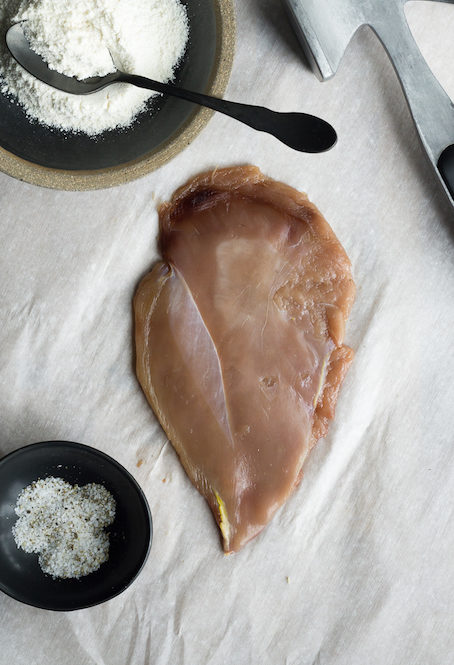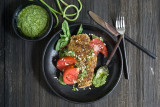
Prep time
10 minutes
Cook time
10 minutes
Course
Main
Skill level
Intermediate
Season
Summer
Serves
4
One of the most interesting aspects of koji flour—rice that has been inoculated with koji mold, dried and ground—is its ability to double as a delicious breading. The enzymes in koji flour convert starch into sugar, making the exterior caramelize when introduced to heat. To capitalize on this chemical reaction, I enjoy making koji-fried pheasant cutlets. The thin pieces of succulent meat have a sweet and crunchy crust that I crave.
Koji flour is completely safe for human consumption and it’s a staple pantry item for me. In the words of René Redzepi, chef and co-owner of the renowned Danish restaurant Noma and author of The Noma Guide to Fermentation, “It’s a new ace-in-the-hole that occupies a space between an exotic sugar and all-purpose flour.”
You can make koji flour at home by buzzing dried koji rice into a fine powder using a blender or food processor. Store it in an airtight container at room temperature or in a refrigerator.
Think of this recipe as the Asian version of schnitzel or Milanese. The pheasant breasts should be pounded thin, dredged in koji flour and then quickly pan-fried to a golden brown. Because of the sugar in the koji flour, the crust develops rapidly. Luckily, pheasant cooks just as fast.
To balance out the richness of the koji-fried pheasant, pair it with a bright herb salad that’s packed with flavor and spice. The acidity from the lime adds an interesting element that reminds me of chicken brined in pickle juice. You can double up on the herb salad and add crisp lettuce to make it a full side dish, or serve it with fried rice.
If you’re unfamiliar with koji, check out my introductory article on this culinary phenomenon.
Ingredients
Pheasant
- 4 pheasant breasts
- ½ cup koji flour
- Kosher salt and pepper
- Butter or oil for cooking
- Lime wedges for serving
Herb Salad
- 2 cups of mixed herbs such as parsley, cilantro and/or basil
- 1 tbsp. fresh lime juice
- 2 tbsp. roasted garlic oil or neutral-flavored oil (avocado, canola, grapeseed, etc.)
- 1 tsp. toasted sesame oil
- ½ jalapeño, seeds removed and sliced paper-thin
- 1 green onion, sliced thin
- Garnish with sesame seeds, optional
Also works with
Special equipment
Preparation
Herb Salad
- Make the herb salad by pouring the lime juice into a small bowl.
- Slowly add the oils and whisk until emulsified.
- Fold in the herbs, jalapeño, green onion and a sprinkle of sesame seeds, if desired. Set aside.
Pheasant
- If possible, season the pheasant breast with a generous sprinkle of salt and pepper a day in advance.
- Make sure the meat is very dry. Pat with paper towels if needed. Place the pheasant breasts between two sheets of parchment or wax paper. Use a meat mallet to gently pound each breast into thin cutlets, about ¼” thick.
- Sprinkle each breast with salt and pepper if not seasoned in advance. Spread the koji flour across a plate and then dredge both sides of the pheasant breast in it. Shake off any excess.
- In a large sauté pan over medium heat, add a small glug of oil or pat of butter. Once hot, use tongs to lay each breast down, leaving room in between each. Do not overcrowd the pan; work in batches if needed. While searing, use a spatula to press down the center of each breast to flatten and brown evenly. After about 2 minutes, flip and sear on the other side. If the meat begins to darken too fast, lower the heat so that it can cook all the way through without burning. The outside color should be dark golden brown.
- Serve the koji-fried pheasant cutlets with a spoonful of herb salad and lime wedges.
Sign In or Create a Free Account
Reviews
Koji-Fried Pheasant

Prep time
10 minutes
Cook time
10 minutes
Course
Main
Skill level
Intermediate
Season
Summer
Serves
4
One of the most interesting aspects of koji flour—rice that has been inoculated with koji mold, dried and ground—is its ability to double as a delicious breading. The enzymes in koji flour convert starch into sugar, making the exterior caramelize when introduced to heat. To capitalize on this chemical reaction, I enjoy making koji-fried pheasant cutlets. The thin pieces of succulent meat have a sweet and crunchy crust that I crave.
Koji flour is completely safe for human consumption and it’s a staple pantry item for me. In the words of René Redzepi, chef and co-owner of the renowned Danish restaurant Noma and author of The Noma Guide to Fermentation, “It’s a new ace-in-the-hole that occupies a space between an exotic sugar and all-purpose flour.”
You can make koji flour at home by buzzing dried koji rice into a fine powder using a blender or food processor. Store it in an airtight container at room temperature or in a refrigerator.
Think of this recipe as the Asian version of schnitzel or Milanese. The pheasant breasts should be pounded thin, dredged in koji flour and then quickly pan-fried to a golden brown. Because of the sugar in the koji flour, the crust develops rapidly. Luckily, pheasant cooks just as fast.
To balance out the richness of the koji-fried pheasant, pair it with a bright herb salad that’s packed with flavor and spice. The acidity from the lime adds an interesting element that reminds me of chicken brined in pickle juice. You can double up on the herb salad and add crisp lettuce to make it a full side dish, or serve it with fried rice.
If you’re unfamiliar with koji, check out my introductory article on this culinary phenomenon.
Ingredients
Pheasant
- 4 pheasant breasts
- ½ cup koji flour
- Kosher salt and pepper
- Butter or oil for cooking
- Lime wedges for serving
Herb Salad
- 2 cups of mixed herbs such as parsley, cilantro and/or basil
- 1 tbsp. fresh lime juice
- 2 tbsp. roasted garlic oil or neutral-flavored oil (avocado, canola, grapeseed, etc.)
- 1 tsp. toasted sesame oil
- ½ jalapeño, seeds removed and sliced paper-thin
- 1 green onion, sliced thin
- Garnish with sesame seeds, optional
Also works with
Special equipment
Preparation
Herb Salad
- Make the herb salad by pouring the lime juice into a small bowl.
- Slowly add the oils and whisk until emulsified.
- Fold in the herbs, jalapeño, green onion and a sprinkle of sesame seeds, if desired. Set aside.
Pheasant
- If possible, season the pheasant breast with a generous sprinkle of salt and pepper a day in advance.
- Make sure the meat is very dry. Pat with paper towels if needed. Place the pheasant breasts between two sheets of parchment or wax paper. Use a meat mallet to gently pound each breast into thin cutlets, about ¼” thick.
- Sprinkle each breast with salt and pepper if not seasoned in advance. Spread the koji flour across a plate and then dredge both sides of the pheasant breast in it. Shake off any excess.
- In a large sauté pan over medium heat, add a small glug of oil or pat of butter. Once hot, use tongs to lay each breast down, leaving room in between each. Do not overcrowd the pan; work in batches if needed. While searing, use a spatula to press down the center of each breast to flatten and brown evenly. After about 2 minutes, flip and sear on the other side. If the meat begins to darken too fast, lower the heat so that it can cook all the way through without burning. The outside color should be dark golden brown.
- Serve the koji-fried pheasant cutlets with a spoonful of herb salad and lime wedges.






